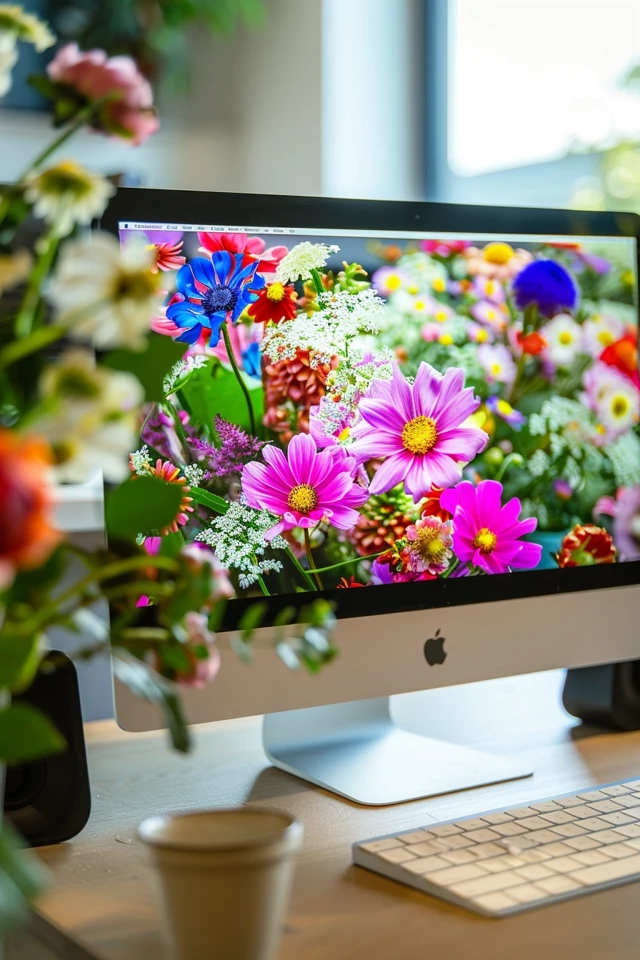To enhance your photos with beautiful floral overlays and unleash your creativity, follow these essential digital editing tips on how to add flowers to a picture. By utilizing the power of Adobe Lightroom and other photo editing software, you can transform your images into stunning works of art. Let’s begin with some tips on selecting and editing the best flower photo.
Key Takeaways:
- Learn how to select and edit the best flower photo using Adobe Lightroom.
- Master camera settings for capturing vibrant flower images.
- Discover how to add floral backgrounds to your photos using photo editing software.
- Enhance your images with flower overlays for a creative touch.
- Get tips on digital flower placement for a natural and realistic result.
Selecting and Editing the Best Flower Photo
Before diving into the editing process, it’s important to select the best flower photo to work with. In Lightroom’s library module, compare a group of images and choose the one that stands out.
Start by making global adjustments such as white balance, exposure, and contrast. Bring out the colors of the flowers using saturation and vibrance sliders. For more control over individual colors, use the HSL/Color/B&W panel. Enhance the texture or softness of the flowers with the clarity slider. Adjust the exposure using radial filters to make the flower stand out. Lastly, remove any imperfections with the spot removal tool.

“The key to captivating flower photography lies in selecting the right image and enhancing it with precise editing techniques. With Lightroom, I’m able to bring out the true essence of the flowers and make them truly eye-catching.”
By carefully selecting and editing the best flower photo, you can transform an ordinary capture into a stunning masterpiece. The combination of image selection and various editing tools in Lightroom allows you to unleash your creativity and truly elevate your flower photography.
Camera Settings for Flower Photography
To capture the vibrant colors and intricate details of flowers, using the right camera settings is crucial. When photographing flowers, it’s important to adjust your camera’s ISO, shutter speed, aperture, and depth of field to achieve the best results.
ISO
Set your ISO to a low value between 100 and 200 to maintain sharpness and avoid grainy photos. This will ensure that the fine details of the flowers are preserved and the colors appear crisp and vibrant.
Shutter Speed
Use a fast shutter speed of around 1/125 or higher to minimize blur caused by camera shake or wind. Flowers can be quite delicate, and even the slightest movement can result in a blurry image. By using a fast shutter speed, you can freeze the motion and capture sharp, clear photos.
Aperture and Depth of Field
The aperture setting plays a crucial role in flower photography. For small subjects such as individual flowers or petals, choose a wide aperture (low f-stop number, such as f/2.8) to create a shallow depth of field. This will help to blur the background, drawing attention to the main subject and adding a sense of depth to the image.
On the other hand, for larger subjects or group shots of flowers, select a narrow aperture (higher f-stop number, such as f/11) to ensure that the entire subject is in focus. This is especially important when capturing macro shots or close-ups of intricate flower arrangements.
Aperture Priority Mode
Most photographers prefer shooting flower photography in aperture priority mode. This allows you to easily adjust the aperture while the camera automatically adjusts the shutter speed to achieve the correct exposure. It gives you more control over the depth of field and enables you to experiment with different artistic effects.
Remember, the camera settings mentioned above are just guidelines. Feel free to adjust and experiment with them based on the lighting conditions, the type of flowers you’re photographing, and the creative vision you have in mind.
By mastering the camera settings for flower photography, you’ll be able to capture stunning images that showcase the beauty and intricacy of flowers. So grab your camera, head out into nature, and let your creativity bloom!

Adding Floral Backgrounds to Photos
If you’re looking to add a touch of floral beauty to your photos, there’s an easy way to do it with photo editing software like Facetune. With just a few simple steps, you can transform your ordinary pictures into stunning works of art with beautiful floral backgrounds.
First, choose your favorite photo and open it in Facetune. Once you have it open, navigate to the backdrop feature, where you’ll find a wide selection of floral patterns and designs to choose from. Browse through the options and select the one that best complements your image.
Here’s where the fun begins. You can layer multiple designs to create a unique and customized look. Don’t worry about the placement; with the fix tool, you have complete control over where the floral background appears in your photo. Adjust it until it perfectly enhances your composition and brings out the beauty of your subject.
Once you’re satisfied with the result, save your edited image and share it with others to showcase your creative flair and eye-catching floral backgrounds. Whether you’re sharing it on social media or printing and displaying it in your home, your photos will stand out and captivate viewers with their personalized touch of floral charm.


